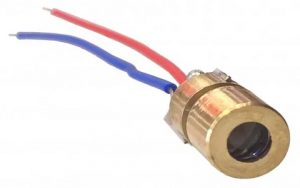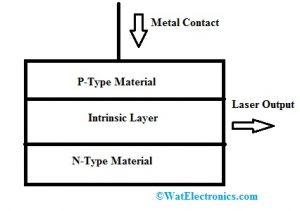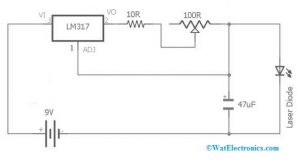In present photonics technology, LASER diodes play an essential role. The term LASER stands for “Light Amplification by Stimulated Emission of Radiation”. A Laser Diode is a p-n junction diode that emits laser radiation once the current is applied in forward direction. These diodes operate on the optical & electrical properties of semiconductor materials & PN junctions. The process used to emit coherent light in this diode is stimulated emission whereas, in light-emitting diodes, the process used to emit light is the spontaneous emission process. So, the emission of light in LASER is more complicated as compared to LEDs but the materials used in both diodes are the same. The wavelength of these diodes ranges from the visible to the IR based on the active layer’s material. This article discusses an overview of the LASER diode and its working with applications.
What is Laser Diode?
A semiconductor device that is used to generate high-intensity coherent light by using the process like Light Amplification by Stimulated Emission of Radiation (LASER) is called a laser diode which generates laser light. Here, coherent light means the light signals which are generated through the device include the same phase and frequency. This diode works on the principle of stimulated emission which is similar to LED.

Laser Diode
The sunlight or incandescent bulbs have waves with several wavelengths but they are not in phase with each other. But these diodes generate a thin laser light beam where all the light signals contain the same wavelengths & they move together. So, laser rays are extremely bright which targets an extremely small spot. These are used in different devices like barcode readers, laser printers, security systems, FOCs (Fiber optic communications), LIDAR, etc. Laser diode temperature typically selected between 20 to 25 °C.
LASER Diode Construction
The construction of a laser diode can be done using different materials like metal contact, p-type material, n-type material & intrinsic layer. The input terminals of this are connected toward metal plates which are inserted into the p-type and n-type layers. An alternative name of this diode is Homojunction Laser Diode.

Laser Diode Construction
The intrinsic region used in between the p-type & n-type material is to enhance the capacity of the active region so that more charge carriers can build up at the junction. This permits several electrons to combine through holes at any time, so gives better output power. The laser light is generated from the elliptical region that can be focused through an optical lens. This whole arrangement of the PIN diode is enclosed usually within a metal casing.
Types of LASER Diode
These are available in different types which include the following.
Double Heterostructure
In this type of diode, the material like Heterostructure is sandwiched in between two materials like p-type & n-type. This type of diode is known as double heterostructure laser diode due to the heterostructure material presence. The main benefit of this diode is that the active region can be used for enhanced optical amplification.
Quantum Well
In this diode, the quantum well layer is located in the middle of the diode. The quantum energy is mainly used for changing the charge carriers like electrons from upper to lower energy & is accountable for improved efficiency.
Separate Confinement Heterostructure
The thin middle layer in the quantum well laser diode is extremely small for confining generated light efficiently. To balance this within the separate laser diode, additional two layers are included on the three first layers. These layers contain a less refractive index & assist in confining the generated light efficiently.
Vertical-Cavity Surface-Emitting
In this kind of laser diode, the optical cavity is along with the current flow axis. Some other types of laser diodes are Quantum Cascade, Interband Cascade, Distributed Bragg Reflector, Distributed Feedback Laser Diode, External Cavity & VCSEL (Vertical External Cavity Surface Emitting Laser Diode).
Laser Diode Driver Circuit
Laser diodes need complex drive circuits which use feedback loops to measure temperature, input current, o/p optical power & voltage. The circuit diagram of the laser diode is shown below which is build with an LM317 IC. Here, IC LM317 is connected to work as a constant current source. The output current mainly depends on the resistance value between Vadj & Vout of the voltage regulator.

Laser Diode Circuit Diagram
The output current can be changed through a 100R potentiometer which supplies into the diode. The resistor used in the circuit like 10R is used to restrict large currents once the potentiometer is at zero. Here, a capacitor like 47uF is mainly used to absorb the spikes of voltage from the battery.
Laser Diode Working
This diode working mainly involves three processes like absorption, spontaneous & stimulated emission.
Absorption
In this process, once an external energy source is given to the electrons then the flow of electrons can jump from one energy level to another like low to high which is also called valence to the conduction band.
Spontaneous Emission
In the spontaneous emission process, if the flow of electrons within a higher level of energy is not stable then immediately they start moving toward the low level of energy. However, if they jump from one energy level to another like high to low then they will definitely generate the energy which is the difference between the two levels. Here, the released energy will be in light form, so photons will be generated. So this entire process is called spontaneous emission.
Stimulated Emission
In this kind of emission, the photons hit electrons at a high level of energy, supplied from an exterior source of light energy. Once these photons hit the electrons, then immediately they will gain energy & recombine through holes to generate an additional photon. Therefore, one incident photon motivates another photon to let go. Therefore, this process is known as stimulated emission.
Characteristics
The characteristics of laser diode include the following.
In the above characteristics, the vertical line denotes the optical power of generated light whereas the horizontal line specifies current. So from the above characteristics, we can notice that, once the power reaches threshold voltage then the power will be increased gradually for a little increase within the current. The power generated through this diode is dependent on the associated temperature along with the device.
The properties of the laser diode are coherence, monochromaticity, brightness & directionality.
Please refer to this link for Choosing resistor values for diodes.
Difference between LED & Laser Diode
The main difference between LED and Laser Diode includes the following.
|
LED |
LASER |
| LED stands for light-emitting diode | LASER stands for light amplification by stimulated emission of radiation |
| LED doesn’t require feedback | LASER requires feedback |
| LED is not highly directional | It is extremely directional |
| LED is polychromatic | It is extremely monochromatic |
| Spontaneous emission is accountable for it. | Spontaneous emission is accountable for it. |
| LEDs generate a different and incoherent light ray. | The laser generates a coherent & monochromatic light signal |
| It is not reliable | It is highly reliable |
| Quick response | As compared to LED, LASER response is faster. |
| Moderate bandwidth | Higher bandwidth |
| Not energetic | Highly energetic |
| LEDs are two types like surface emitter & Edge emitter | LASER is two types like Gas & Semiconductor Laser |
| LEDs are reliable, small in size, and uses small power. | Laser’s are less reliable, big & uses more power as compared to LED |
| LED drive current ranges from 50A to 100mA | LASER drive current ranges from 5A t0 40mA. |
Advantages
The advantages of laser diode include the following.
- As compared with other diodes, the operational power of the laser is low
- These diodes can be handled very easily
- The high-efficiency light can be generated.
- Power consumption is low
- Manufacturing and operation cost is less
- Operates for a long time
- Reliable highly
Disadvantages
The disadvantages of laser diode include the following.
- As compared to other diodes, it is expensive
- Laser rays are very harmful to the eyes
- These are temperature-dependent, once the temperature increases then this diode operation will be affected.
- Not applicable for high power applications
Applications
The applications of laser diode include the following.
- These diodes are used extensively in different industries like defense and telecommunication
- The laser beam is used for transmission of signal within optical fiber communication also because optical finer uses high focused beam.
- It is used as a barcode reader
- Lasers are used in the medical field for different treatments.
- It is used in CD & DVD players
- In telecom, these are used as the main source with 1.3 & 1.5-micrometer bands
- Lasers are high-intensity signals which are used in industries for different purposes like drilling, welding & cutting.
Please refer to this link to know more about LDO Regulator.
Thus, this is all about an overview of laser diode and its working. These are used in major electronics fields like consumer electronics, medical devices, autonomous vehicles, scientific devices, industrial applications, etc. Laser diodes wavelength ranges from 810 – 1064 nm wavelengths. Here is a question for you, what is a laser diode module?